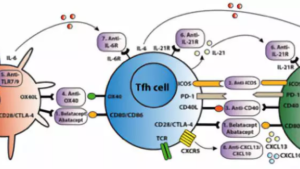October 28, 2024, Immune Tolerance

The vibrant pomegranate blossoms blaze in May, green willows droop heavily under the rain. Five-colored silk wraps the corner of the zongzi, presented on a golden plate, with raw silk fans painted with twin phoenixes.
It is the season for bathing with orchids, sweet calamus wine shared in clear reverence. Amid the leaves, a yellow oriole sings briefly, still groggy, casually startling dreams behind the silk screen.
—Ouyang Xiu
Time flies; it feels as though the peach blossoms have not faded for long.
In the blink of an eye, the vibrant pomegranate blossoms are in full bloom.
The Dragon Boat Festival holiday is approaching.
What travel plans do you have for the holidays?
Today, we continue our discussion on kidney transplantation.
Kidney transplantation is the optimal alternative treatment for patients with uremia.

With evolving attitudes toward organ donation among our citizens, an increasing number express a willingness to donate organs after death.
This means that more patients with uremia have a greater opportunity for a renewed “kidney” life sooner.
Before undergoing a kidney transplant, a thorough understanding of the procedure is essential.
Today, Dr. Zhu will discuss with you the most critical issue following kidney transplantation: rejection.
1. Why Does Rejection Occur After Kidney Transplantation?
Answer: Our body’s immune system can recognize and eliminate any “foreign objects” that enter it, such as bacteria and viruses. This is known as immunity. Unfortunately, the newly transplanted kidney is also perceived as “foreign” and is attacked by the immune system, a condition known as rejection. Without effective treatment, these attacks can be fatal to the transplanted kidney.
2. How Can You Tell If Rejection Is Occurring?
Answer: Due to the use of potent immunosuppressants, the symptoms of rejection are becoming increasingly atypical. However, be vigilant for potential rejection if the following symptoms appear after a kidney transplant, and contact your kidney transplant doctor immediately:
Pain in the renal allograft area, with the allograft becoming stiff and enlarged.
Fever, with a body temperature exceeding 38°C and no clear signs of infection.
A sudden reduction in urine output.
Sudden weight gain.
Swelling of the hands and feet.
Elevated blood pressure.
3. If I Feel No Discomfort, Can I Be Certain That No Rejection Has Occurred?
Answer: No. As noted in the previous question, rejection is becoming increasingly atypical. Most rejections initially lack obvious symptoms, and routine tests may only reveal an increase in serum creatinine. Even among some patients with normal creatinine levels, renal biopsy results may indicate rejection, necessitating medication adjustments based on pathological findings. For your safety, regular follow-up visits after kidney transplantation, as prescribed, are essential.
4. What Types of Rejection Exist?
Answer: Rejection can be classified into various types based on different criteria, with its mechanisms primarily involving cellular immunity and humoral immunity. The most common form, acute rejection, is primarily mediated by cellular immunity, whereas hyperacute rejection and chronic rejection are predominantly mediated by humoral immunity. However, rejection often involves the combined action of cellular and humoral rejection, making it challenging to fully differentiate between the two. Clinical diagnosis typically concludes based on the predominant mechanism involved.
5. When Does Rejection Occur After a Kidney Transplant?
Answer: Rejection can occur at any time following kidney transplantation. We typically describe acute rejection as most likely to occur within the first 6 months after kidney transplant surgery, particularly within the first 3 months, when its incidence is highest, though it decreases thereafter. However, acute rejection can still occur even many years after transplantation. Chronic rejection generally occurs between six months and one year after kidney transplantation.
6. Is It Necessary to Remove Some of the Precious Glomeruli During a Biopsy of a Transplanted Kidney?
Answer: We can confidently assure you that a needle biopsy of a kidney transplant is necessary. Each kidney contains approximately 1 million glomeruli, and we only extract about 10 to 20 glomeruli per biopsy, so there is no need to worry about their loss. While renal biopsy does carry certain risks, such as bleeding, the incidence is very low, and our transplant center has never experienced significant complications from renal biopsies. Most importantly, biopsy pathology can differentiate between rejection and drug toxicity, and can specify the type of rejection. The results directly influence the subsequent treatment plan and the recovery of the transplanted kidney; therefore, it is unnecessary to avoid a renal allograft biopsy out of fear of complications.

The Kidney Transplantation Center of Zhongshan Hospital, affiliated with Fudan University, boasts a long history of kidney transplantation and successfully performed China’s first kidney transplant in a child with Denys-Drash syndrome. In collaboration with the Shanghai Soong Ching Ling Foundation, we have established the “New Kidney” charity fund to provide charitable assistance to families of kidney transplant patients facing financial difficulties.
We will work hand in hand with you to alleviate the suffering of patients with uremia.

Written by | Zhu Dong, Edited by | Zhu Dong
This article is an original publication of the “Kidney Transplantation, Zhongshan Hospital, Fudan University” WeChat public account. Reproduction requires authorization from this account and the original author, with proper attribution. To care for your kidneys, start by following the “Kidney Transplantation, Zhongshan Hospital, Fudan University” WeChat public account. You can also click [Read the Original] to explore “Living Donor Kidney Transplant: A Gift of Life.”




